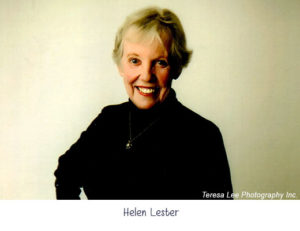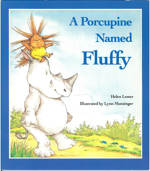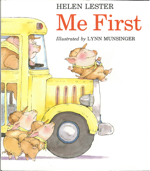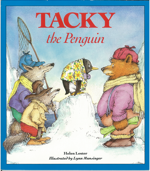“I don’t think the thrill of turning a page to see what happens next will ever go out of style.”
Children’s books are the cornerstone of many of Collaborative Classroom’s programs; in a way, the authors are our behind-the-scenes collaborators. We want teachers, administrators, students, and parents to be able to learn more about these wonderful authors. We are happy to present the first of a series of author interviews, with Helen Lester.

Collaborative Classroom: Your stories can be deceptively simple but they often convey a larger message (e.g., being different in Tacky and “Who am I?” in Fluffy). Do you start with the message or does it emerge as you conceive the story?
Helen Lester: I usually start with a list of issues I feel are important to my readers, be they children or adults-being different (Tacky), teasing and bullying (Hooway for Wodney Wat), fear (Something Might Happen), pushiness (Me First); all I have to do is think back on my years as a teacher and my old students give me a wealth of material.
Collaborative Classroom: Your stories and/or characters work on several levels. For example, Fluffy’s motivation to explore who he is is fairly sophisticated. Kids may not want to identify with Pinkerton, but they probably know that they have something in common with him. “Tacky stood alone” is both comical and quietly powerful-a moment that captures the essence of being unique and separate from one’s peers, yet firm in the face of a threat to the group. Do you imagine that both children and adults will see themselves in your characters? Do you strive to appeal to both audiences?
Helen Lester: I think my “characters’ characteristics” cross all age barriers-one can be as funny, loud, or selfish at eight as one can at 80! Also, I hope some of my humor that may skim over the head of a five-year-old may appeal to the wonderful, dutiful adult who is reading to the child.
Collaborative Classroom: We teach a writing process in our Being a Writer program. What could children learn from your process? Do you struggle with any of the steps in your process?
Helen Lester: I often begin my stories by building up a problem. For example, in my Tacky books (tacky books?), I start by thinking of weird things Tacky might do. One after another. Weirder and weirder. What fun. I could go on forever! But sooner or later that “uh-oh” moment is upon me; yikes, I’ve got to come to some sort of solution. This is where the struggle begins, and I am stuck. What do I do when I am stuck? I wail, “I’m STUCK.” At this point I remind myself that I’m not stuck, I’m just thinking. After all, you can’t write without thinking, even though it’s hard work.
Collaborative Classroom: During a read-aloud, we often ask students to close their eyes and visualize the story before seeing the illustrations. How do you collaborate with the illustrator? When you read your books aloud to children, what do they react to the most?
Helen Lester: When I visit schools, I love to hear the children react to the pictures. Long before, as I was writing the story, I did so with my wonderful illustrator Lynn Munsinger very much in mind. It’s sort of like we’re on the same baseball team; I pitch a line or situation to her knowing full well that-wham!-she’ll hit a home run. So it’s a joy to hear the children roar with laughter in response to the situations Lynn and I have led them into.
Collaborative Classroom: Your books are light-hearted and humorous, and you focus on strong, funny protagonists. Was humor a big part of your family life growing up?
Helen Lester: Well, my three brothers and I thought we were pretty funny. Funnier than our parents thought we were.
Collaborative Classroom: How and when did you start writing?
Helen Lester: In the early ’70s, after spending 10 years in second grade (as the teacher), all of my old students came back to haunt me. The weird ones (Tackys), the ones who were auditorily challenged (as was Buddy in Listen Buddy), the pushy Pinkerton Pigs, the timid Wodney Wats-they were all there just waiting for me to tell their stories. You might say I’ve just turned my second-graders into animals!
Collaborative Classroom: What attracts you to a book?
Helen Lester: What really appeals to me is humor in both the illustrations and the writing. I was inspired by James Marshall, for he would make me laugh when I was reading to my sons at 7:30 each night, and sometimes things are not all that funny at 7:30 p.m.! His characters were so human. Never mind that they might be hippos or foxes. And his drawings were simply simple. And simply hilarious.
Collaborative Classroom: What are you reading right now?
Helen Lester: One mystery after another-I love creepy foggy scenes that give me the shivers. My favorite mystery writer is Peter Robinson, an Englishman (what else?!)-and I am always eagerly waiting at the bookstore, my nose pressed to the window, for the next P.D. James.
Collaborative Classroom: You’ve had a lot of experience in the classroom over the years-as a teacher, as a visiting author, and perhaps as a parent, too. What have you found remains the same for students and/or teachers and what has changed?
Helen Lester: Human nature, be it that of a child or an adult, remains the same and I love the students and teachers that I meet on my school visits. The students are bright-eyed, bushy-tailed eager beavers and the teachers, bless their hearts, are gamely keeping literature alive despite the distractions of the electronic age and, I must add, the testing pressures.
Collaborative Classroom: What do you think about the way your books are used to teach comprehension and writing in our curricula?
Helen Lester: Center for the Collaborative Classroom is verrrrry impressive, and doing wonderful things in the classroom for students and teachers. I was thrilled to see my books in the Making Meaning and Being a Writer programs. In fact, I am so impressed with your programs that I loaned some of the materials to a teacher friend and now I can’t get them back!
Collaborative Classroom: In this era of rapidly changing means of publication where there’s a multitude of additional entertainment options (e.g., e-books, computer games, movies, social media, etc.), how would you describe the role of printed books in children’s lives?
Helen Lester: I don’t think the thrill of turning a page to see what happens next will ever go out of style.
